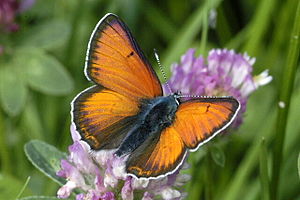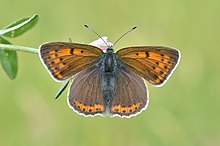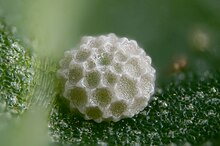Purple Gold Fire Butterfly
| Purple Gold Fire Butterfly | ||||||||||||
|---|---|---|---|---|---|---|---|---|---|---|---|---|

Male of the Lilagold Fire Butterfly ( Lycaena hippothoe ) |
||||||||||||
| Systematics | ||||||||||||
|
||||||||||||
| Scientific name | ||||||||||||
| Lycaena hippothoe | ||||||||||||
| ( Linnaeus , 1761) |
The Lilagold-Feuerfalter ( Lycaena hippothoe ) is a butterfly ( Tagfalter ) from the family of the Bluebirds (Lycaenidae). It is also sometimes referred to as the little dock butterfly. The specific epithet is derived from Hippothoe, a sea nymph from Greek mythology .
features
The purple gold fire butterfly is a small and rare butterfly. The upper sides of the wings of the male moths are colored bright red and at the edges they usually shimmer purple. The wing tops of the female moths are colored yellow-brown and the wing edges are lined with white. The differentiation to other types of fire butterflies is made by the characteristic drawing of the wing undersides.
Similar species
- Little fire butterfly ( Lycaena phlaeas )
- Great fire butterfly ( Lycaena dispar )
- Ducat butterfly ( Lycaena virgaureae )
- Purple fire butterfly ( Lycaena alciphron )
- Lycaena ottomana
Subspecies
- Lycaena hippothoe eurydame (Hofmannsegg, 1806). Geneva , Switzerland . Males without a purple tinge on the upper side of the wing. Occurrence: French Alps , Switzerland, Italy , Austria , Apuan Alps , Apennines . The species flies in one generation from July to mid-September (depending on the altitude). Forage plants are snake knotweed ( Polygonum bistorta ) and meadow sorrel ( Rumex acetosa ). The caterpillars overwinter.
- Lycaena hippothoe stiberi Gerhard, 1853. Lapland . In the females, the tops of the forewings are colored orange to the edges. The wing tops of the males are lighter. The underside of the forewing is colored more intensely orange in the cell area. The hind wing underside is gray in both sexes and the submarginal bandages on the upper side and the hind wing underside are more extensive and more intense orange. Lycaena hippothoe stiberi is widespread in Fennoscandinavia up to 62 ° N ( Dovrefjeld ) to the North Cape . The species flies in one generation from late June to July. The forage plant of the caterpillar is meadow sorrel ( Rumex acetosa ).
Synonyms
Older and meanwhile uncommon synonyms are:
- Papilio hippothoe Linnaeus, 1761
- Papilio eurybia Ochsenheimer, 1808
- Chrysophanus eurydame Hoffmannsegg 1806; Described by some authors as a subspecies of Lycaena hippothoe .
- Polyommatus stiberi Gerhard, 1853; Described by some authors as a subspecies of Lycaena hippothoe .
Flight time
The purple gold fire butterfly flies in one generation from late May to June.
habitat
Ebert describes the habitat of Lycaena hippothoe as follows:
- " Wet meadows ( cabbage thistle meadows ) in valleys, on clearings and on the edges of the forest, swamp and wet spots on (dry) slopes, in gravel pits , etc., but also on lime-rich grasslands ( dry slopes , juniper heaths ), e.g. on the Swabian Alb . Im Black forest contrast to silicate -Magerrasen ( Nardus grasslands ) Montane fertilized meadows, rushes - and red fescue pastures , arnica meadows in wet meadows with versumpftem or marshy character ... partly on the pastures in. Upper Swabia only in fen -, cabbage thistle-moor grass meadows, Lime moor ... "
Way of life
The females lay their eggs on Rumex acetosa on the stems near the base of opposite leaves or on the base of the leaves. The eggs are found preferably at a height of 25 to 40 centimeters. The caterpillars feed on the common sorrel ( Rumex acetosa ) and at least regionally on snake knotweed ( Persicaria bistorta ). They overwinter as young caterpillars (L3) after the second molt. When searching for nectar, the moths visit the flowers of very different plants, for example. B. Centaurea nigra ( Centaurea debeauxii ), Yarrow , field scabious ( Knautia arvensis ), meadow buttercup ( Ranunculus acris ), snakes knotweed ( Persicaria bistorta ) Broadleaf thyme , great burnet ( Sanguisorba officinalis ), Leucanthemum vulgare ( Leucanthemum vulgare ), spiked devil's claw ( Phyteuma spicatum ), meadow pea ( Lathyrus pratensis ), fence vetch ( Vicia sepium ), bird vetch ( Vicia cracca ).
distribution
Northern Spain, Cantabrian Mountains , Sierra de la Demanda , Sierra Mancilla , Sierra Moncayo . It can still be found from the Pyrenees to 62 ° N in Fennoscandinavia. The species is absent in Great Britain , north-west France, the coastal areas of southern France, northern Netherlands , southern Italy, the southern Balkans and Greece . The species is considered a sensitive bio-indicator for undisturbed meadows.
- Red list FRG: 2 (endangered)
- Baden-Württemberg Red List: 3.
- Saxony Red List: 2 (endangered).
literature
- Hans-Josef Weidemann: Butterflies: observe, determine . Naturbuch-Verlag, Augsburg 1995, ISBN 3-89440-115-X .
- Manfred Koch : We determine butterflies. Volume 1: Butterfly. 4th enlarged edition. Neumann, Radebeul / Berlin 1966, DNB 457244224 .
Web links
- Lepiforum e. V. Taxonomy and Photos
- www.schmetterling-raupe.de
- Species portraits of butterflies in Rhineland-Palatinate - Lilagold-Feuerfalter
- Moths and Butterflies of Europe and North Africa (English)
Individual evidence
- ^ Arnold Spuler: The butterflies of Europe . tape 1 . E. Schweitzerbartsche Verlagbuchhandlung, Stuttgart 1908, p. 57 .
- ↑ a b Tom Tolman, Richard Lewington: The butterflies of Europe and Northwest Africa . Franckh-Kosmos, Stuttgart 1998, ISBN 3-440-07573-7 .
- ↑ Lycaena hippothoe in Fauna Europaea. Retrieved March 7, 2011
- ↑ a b butterflies. 2. Special part: Satyridae, Libytheidae, Lycaenidae, Hesperiidae . In: Günter Ebert, Erwin Rennwald (eds.): The butterflies of Baden-Württemberg . 1st edition. tape 2 . Ulmer, Stuttgart (Hohenheim) 1991, ISBN 3-8001-3459-4 .
- ↑ Gerfried Deschka, Josef Wimmer, The Butterfly Fauna of the Cross Wall, Contribution. Naturk. Upper Austria, 2000
- ↑ Federal Agency for Nature Conservation (Ed.): Red List of Endangered Animals in Germany . Landwirtschaftsverlag, Münster 1998, ISBN 3-89624-110-9 .



